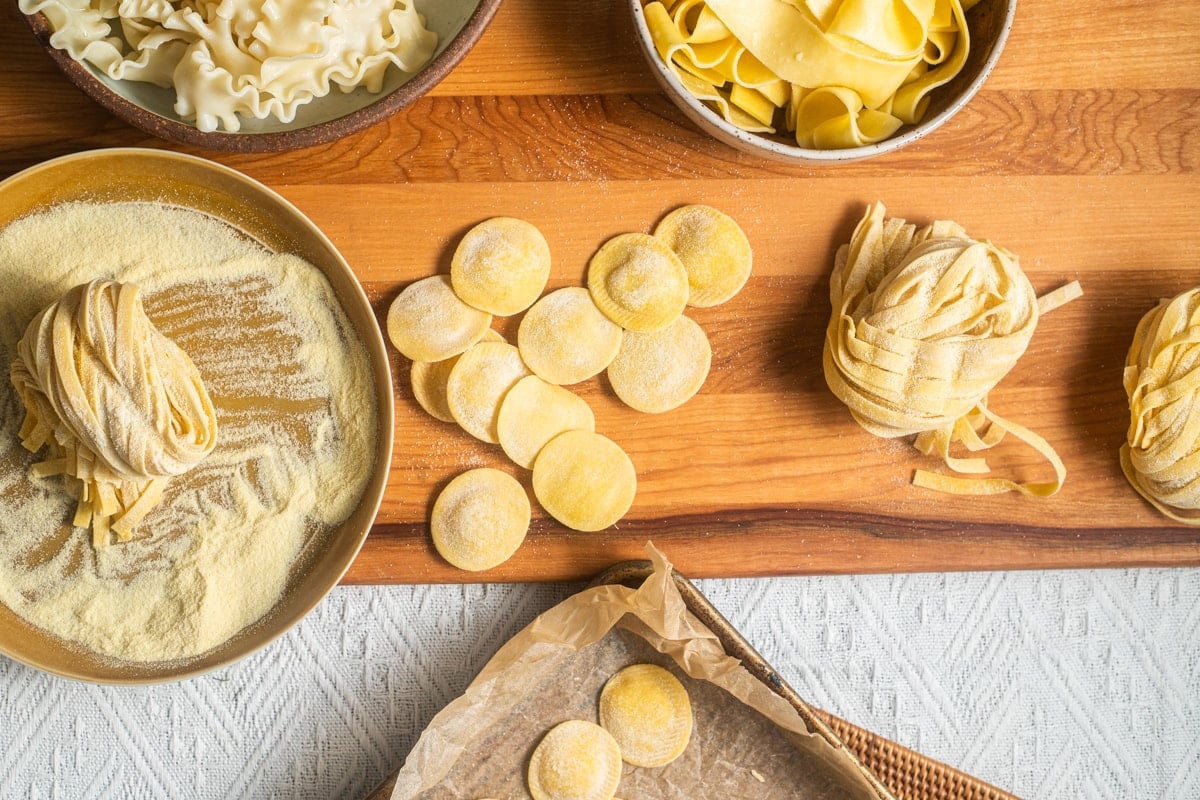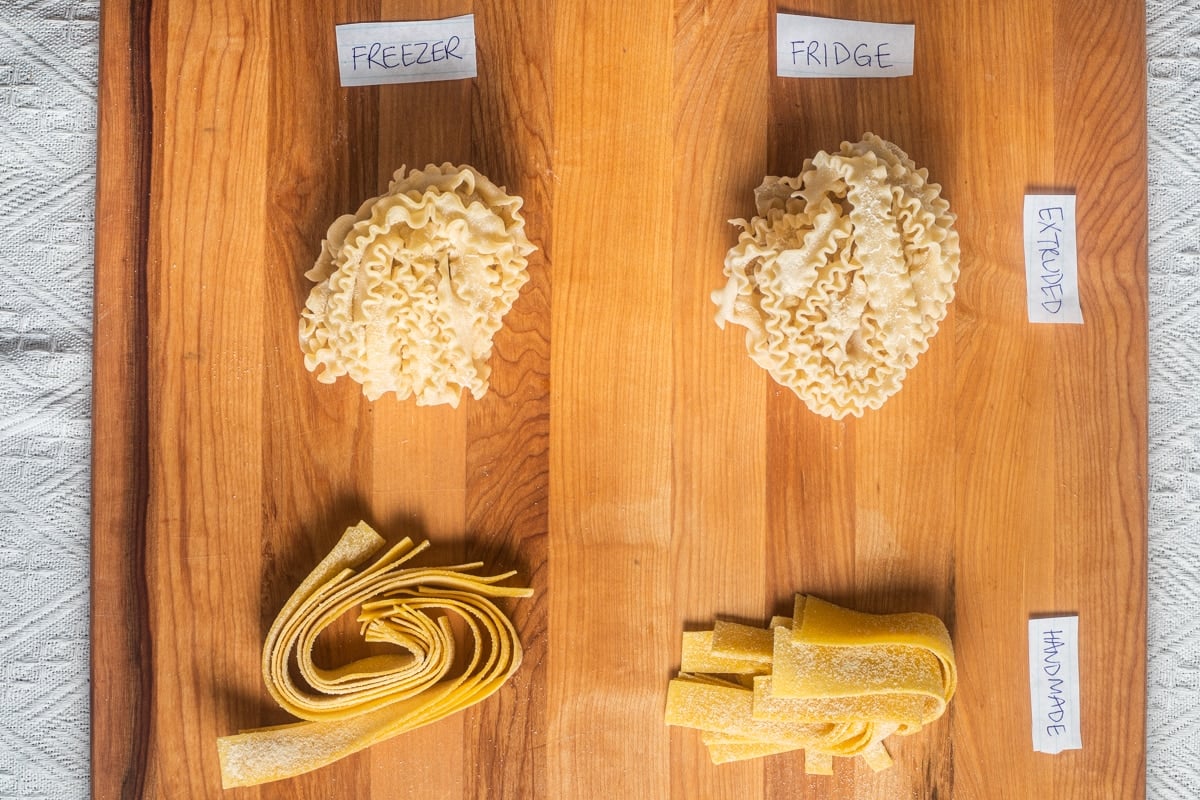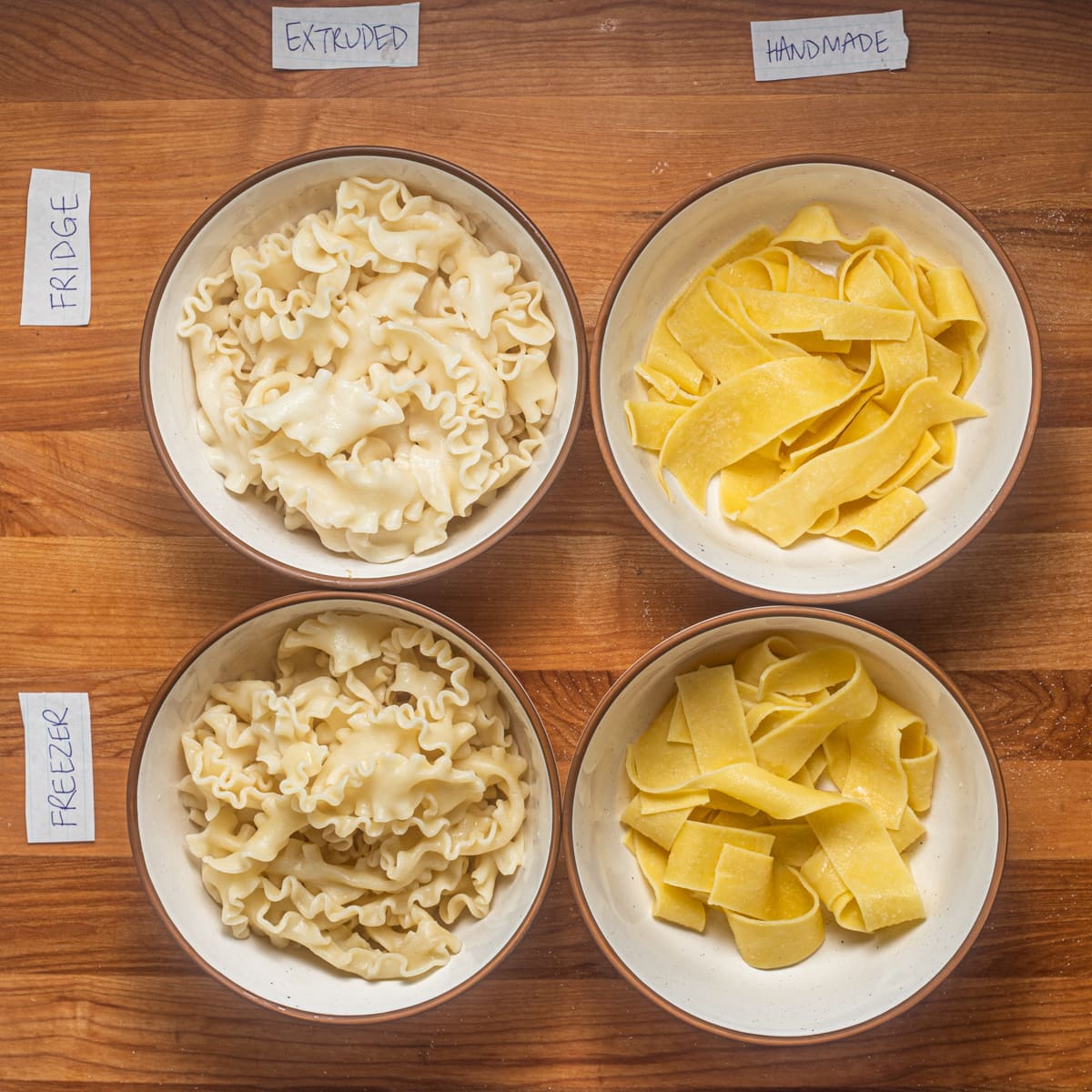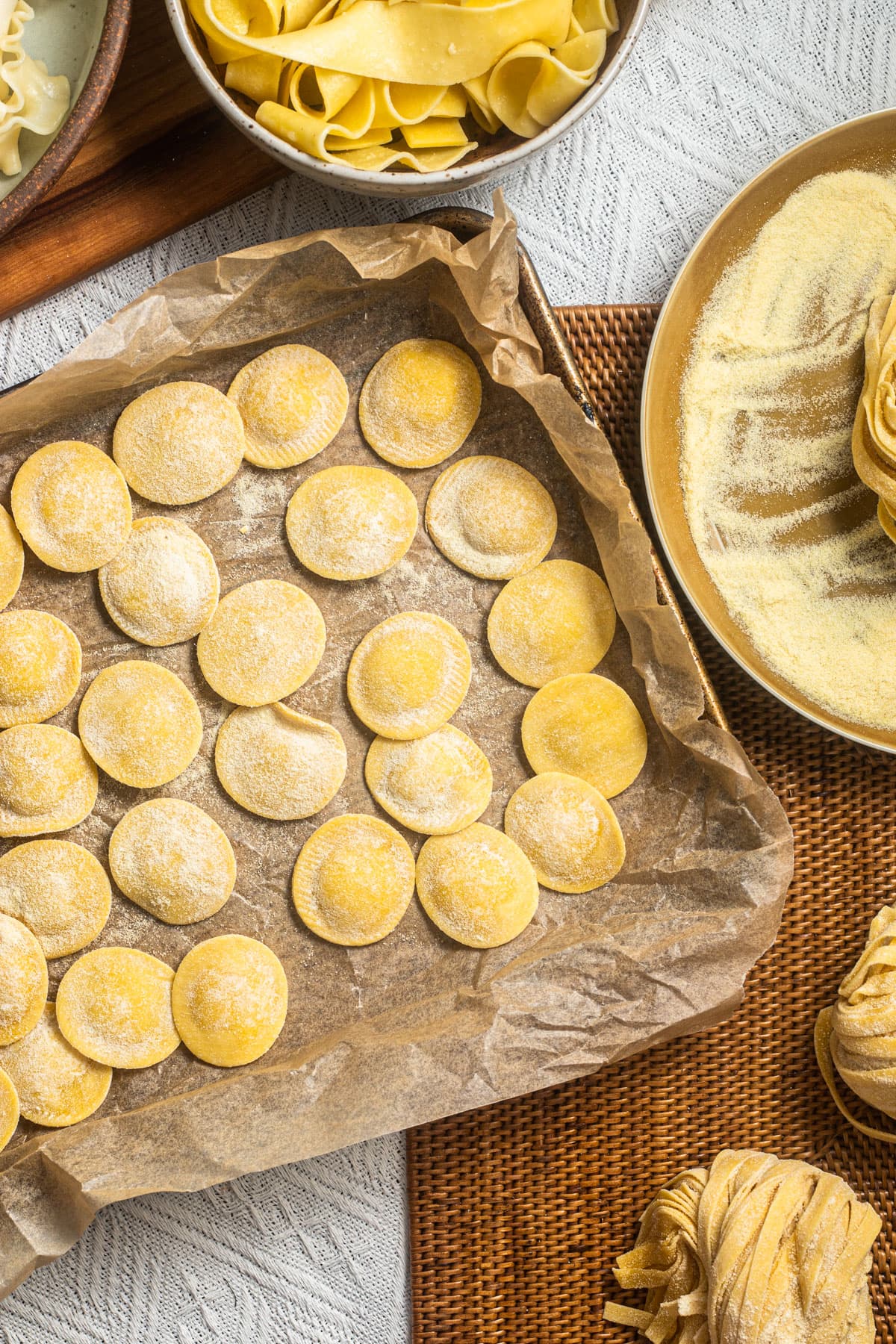In this easy step-by-step guide, we'll walk through the best methods on how to store fresh pasta at room temperature, in the fridge, and in the freezer. I've tested each technique so that you can feel confident storing leftover homemade and store-bought pasta!

Have you ever had leftover fresh pasta dough and wondered what to do with it? I'm in a household of 2, so I often make enough pasta for 4 and have leftover fresh fettuccine, gnocchetti sardi, or ricotta gnocchi. For a while, I wondered what the heck to do with all of that extra pasta. Should I keep it in the fridge? Freeze it? Dry it?
After much research1 and testing, I'm sharing the *best* methods for storing uncooked pasta, from long pasta shapes to delicate hand-formed shapes to fresh ravioli. We'll cover both short-term and long-term strategies for storage. The best part? It requires no special equipment!
Why I Don't Recommend Drying Pasta At Home
Drying your pasta is one of the most common recommendations for longer-term storage. I do not recommend this for several reasons:
- Improperly dried pasta, especially egg doughs, can turn moldy from excess moisture or humidity in the air2. This has happened to me!
- It can also become brittle and crack.
- Even if adequately dried, it will yield a texture similar to dry store-bought pasta, unlike silky strands of fresh noodles.
There's a reason why grocery store brands invest significant time and resources into the drying process. Replicating this at home is a challenging task, and in my opinion, not worth the effort. Now, this might differ if you're extruding pasta or have a dehydrator, but it's not very feasible for the general home cook.
In my experience, the best way to store pasta for long-term use is in the freezer. We'll delve into this method later in the article.
P.S. Looking for a great fresh pasta recipe? Try my Kitchenaid pasta recipe, semolina pasta dough, or homemade pici pasta.
Room Temperature
Let's discuss each storage method in order of duration, from shortest to longest. Unless otherwise stated, these rules apply to both egg and eggless doughs.
- Leftover homemade pasta dough can be stored tightly wrapped in plastic wrap for 1 - 2 hours at room temperature.
- For already cut shapes (or hand-rolled shapes), line a baking sheet with parchment paper (parchment gives extra protection from sticking). Generously, and I mean generously, dust it with semolina flour and evenly arrange the pasta on top, ensuring none of the pieces are touching each other. Keep at room temperature for up to 2 hours.
Max Storage Time: 2 hours. After that point, cook the pasta or transfer it to the fridge or freezer to prevent it from drying out or spoiling. Fresh egg pasta is quick to spoil!
Tips
- For long noodles, like fettuccine or pappardelle, I dust each strand with semolina flour, then wrap a few strands together into a nest.
- My house is usually quite dry, especially in the winter, so I cover the baking sheet with a kitchen towel to keep the shapes from drying out. You can even dampen the towel slightly for added moisture.
Fridge
The fridge is a good option for temporary storage, and the process is quite simple.

Step 1 - Line an airtight container with parchment paper. Generously sprinkle flour on top.

Step 2 - Arrange pasta in a single layer, making sure to dust it with a bit of flour. If you have a lot of pasta, store it between layers of parchment dusted with semolina. Seal the container and store in the fridge.
So, for example, if you are storing homemade farfalle, you would evenly arrange as much pasta in a single layer as you can, dust it with semolina flour, then place another layer of parchment and semolina on top. Add the second layer of pasta, then dust with semolina, and keep repeating as needed.
Max Storage Time: 24 hours. Between 16 - 24 hours, the pasta starts to oxidize and turn a greenish-gray color. It's still edible at this point, but less aesthetically pleasing. Do not consume pasta after 48 hours3). To prevent oxidation, cook the pasta within a few hours or store in the freezer.
Tips
- Toss smaller shapes in a coating of semolina flour before storing to prevent sticking.
- Longer shapes can be wrapped in nests.
Freezer
The freezer is a great method for short and long-term storage. For non-stuffed cuts (fettuccine, pappardelle, orecchiette, etc.), you're going to follow a similar process to the room temperature method.

Step 1 - Line a baking sheet with parchment paper, coat it nicely with semolina flour, then arrange the pasta in an even layer. Freeze, uncovered, for 1 hour until hardened.

Step 2 - Transfer the hardened pasta to an airtight Ziploc freezer bag and store in the freezer. For extra protection from freezer burn, you can wrap them in the parchment paper.
Cook directly from frozen (do not thaw)!
Max Storage Time: 1 - 2 months (1 month for best quality)
Freezing Stuffed Pasta
Stuffed cuts have a slightly different process because they can "crack" or burst when transferred to the freezer, if handled improperly. Cracking can happen due to the sharp temperature change of freezing, causing the filling to expand and burst.
Instead, I recommend blanching first before freezing4.

Step 1 - Blanch the pasta in boiling water for 30 seconds, then drain and transfer to a kitchen towel. Air dry for 15 minutes.

Step 2 - Transfer to a baking sheet with parchment paper and semolina flour, then freeze for 1 hour, uncovered, before storing in an airtight Ziploc bag in the freezer. Cook from frozen (do not thaw).
Fridge vs. Freezer

I was interested in testing any differences in quality between short-term fridge and freezer storage. So, I tested 2 cuts of pasta, one freshly extruded and the other hand cut. I put half of the noodles in the fridge, and half of the noodles in the freezer, making sure everything was well-coated in semolina flour.
After about 20 hours, I cooked each separately to test for any differences in texture or flavor.

Results: I did not notice any major differences in quality between fridge or freezer methods. When cooking the handmade pasta stored in the fridge, a couple of strands stuck together in the boiling water. I did not have this issue with the extruded pasta (stored in the fridge) or the frozen shapes.
I was able to separate the pieces relatively easily, but if you're looking for the most *optimal* texture preservation, I'd recommend the freezer method.
Cooking
Whatever your method, ensure you cook the pasta in well-salted boiling water until al dente. The cooking time will vary depending on the shape, but fresh pasta cooks much more quickly than dried varieties. Frozen shapes will take 30 - 60 seconds longer than room temperature or refrigerated shapes.

FAQs
If you plan on making other shapes from the sheet (i.e., something different than lasagna), I recommend prepping the shapes first and then storing it. You can keep lasagna sheets in the fridge or freeze them for long-term use, as outlined in the post.
If that's all you have, you can. Just note that AP flour is a bit more *sticky* so it's harder to get that floury coating off.
If you have space, you can freeze the pasta on a plate. Or, you can skip the initial freezing step and very, very generously coat the pasta with semolina flour and store it in a freezer bag. I haven't had issues skipping that step with eggless shapes like orecchiette or cavatelli.







This was a great post! Thanks for the quality information! I was wondering how you extrude your mafaldine pasta though! Thanks!
Hi Katie,
Glad it was helpful! Unfortunately, I don't extrude my own mafaldine (I don't have an extruder for mafaldine - though I'd love to learn how to do this as a project some time). Sorry I don't have any tips for you!
Thank you for taking the time, this is extremely helpful!
Hi Lou,
So glad you found it helpful!